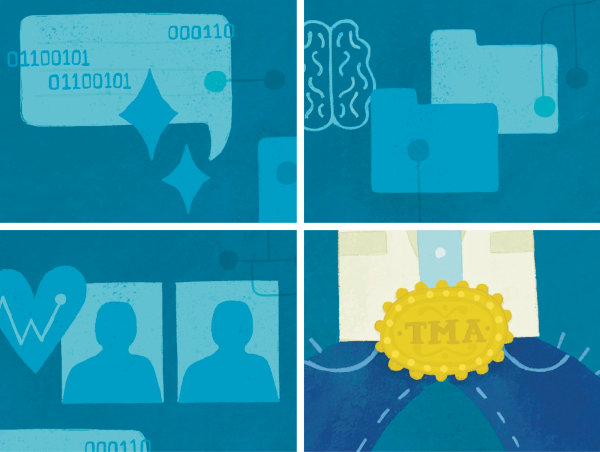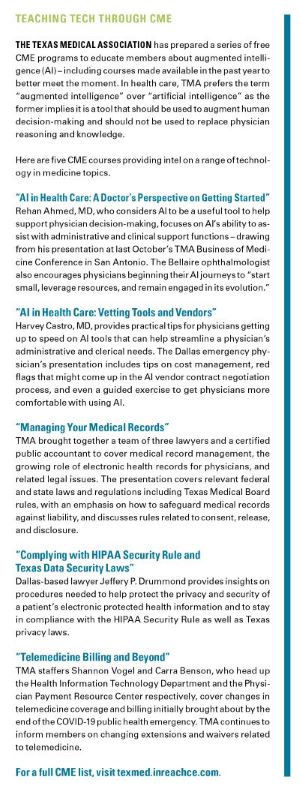
At October 2024’s Business of Medicine Conference in San Antonio, Rehan Ahmed, MD, addressed Texas Medical Association physicians eager to know more about augmented intelligence (AI) – but not all necessarily eager to use AI in their own practices.
“We definitely want to think about AI as a tool to help physicians, not replace physicians,” Dr. Ahmed told Texas Medicine, reflecting on his presentation, which evolved into a continuing medical education (CME) course from TMA on how physicians can use AI to better their practices and overall well-being.
The Bellaire ophthalmologist observed, “[Rather than AI replacing physicians,] it’s going to be physicians who use AI who are going to replace physicians who don’t use AI.”
He noted physicians can use AI in three ways to improve their lives: as an “assistant,” helping physicians schedule appointments and assist with insurance company interactions; as an “agent,” helping interpret data more thoroughly than they can on their own; and as it evolves, as a “superpower” expanding what physicians are able to do.
“The ‘superpower’ refers to AI’s ability to process massive amounts of data and uncover patterns that are either invisible to the human eye or would take a superhuman effort to detect,” Dr. Ahmed explained. “It allows us to stratify patient risk, predict outcomes, and even detect things we traditionally couldn’t – like cardiovascular risk or biological sex from a retinal image. It’s not just about doing what we do faster – it’s about seeing what we can’t.”
His CME course is one of several on AI and other tech topics that TMA recently added to its Education Center.
Such resources are part of the ongoing effort by the association’s Health Information Technology (HIT) Department and Committee on HIT and AI to educate members about the use of various technologies in their practice, whether it be AI, electronic health records (EHRs), telemedicine, or cybersecurity.
Shannon Vogel, TMA’s associate vice president overseeing HIT, notes reducing physician burden is one of the association’s overarching goals for teaching technology and why it houses resources that help physicians and their staffs choose and master tech tools.
G. Ray Callas, MD, TMA’s immediate past president, felt it important for the HIT and AI committee to educate physicians on AI, advocating for that technology to come under the department and committee’s purview.
“Health information technology is very important, but it was missing the augmented intelligence aspect,” Dr. Callas said. “If we’re going to be successful, we have to take the AI bull by the horns and make that something that could be beneficial to help physicians do multiple things.”
“That was a great suggestion,” said Manish Naik, MD, the immediate past chair for the committee. “Any clinician or health care system today is being inundated with vendors coming to them with all kinds of AI solutions. It’s really important for the committee to give the clinicians in Texas some direction on [AI] … and what kinds of guardrails we should have.”
Those questions led TMA to create an Excel-formatted downloadable AI vendor tool, providing 86 questions physicians can use to query vendors on the AI tools they’re offering.
Dr. Naik explained the AI vendor tool is a starting point in evaluating a vendor’s product. He also notes the tool’s questions are grouped into categories to help physicians get at a “high-level” approach to determining which AI tools are right for them.
Given the need to protect health information per privacy laws, the Austin internist noted security questions were folded into a functionality category that factored in questions like “Does the product integrate with EHRs?” and “How are the AI algorithms developed and tested?”
Other key categories include practice impact; pricing; and training, implementation, support, and maintenance, allowing those using the tool to focus on the vital elements needed to integrate new technology into an existing workflow.
TMA has also prepared extensive materials for physicians evaluating EHRs – one technology area many TMA physicians are familiar with. The 2025 edition of TMA’s HIT survey revealed while 91% of respondents are using EHRs in their practices, 69% find their use interferes with attentiveness to patients – an indicator physician satisfaction with EHRs has room for improvement.
That includes a vendor comparison chart showing six of the seven most popular EHRs used by Texas physicians. According to Ms. Vogel, the tool was first created in 2009 when only about 35% of Texas physicians were using EHRs.
For members looking for a review of a potential or existing contract for technology products and/or services, the Coker Group is offering TMA physician members free technology contract review services.
Though an EHR might seem right for a particular practice, a physician won’t truly be able to gauge its efficacy or fit until using it. Philip Bernard, MD, who took over as HIT and AI committee chair June 1, advises physicians not to blindly implement vendor recommendations and insist on customizing settings to match their practice that can help ward off what he calls “alert fatigue.” For example, a palliative care physician doesn’t require alerts on the interactions between opioids and benzodiazepines.
“For physicians who have personalized or customized their [EHR] experience, they get so many hours of return on investment for the minimum amount of effort they spend [on customizing their EHR],” the Dallas pediatrician said. “If you aren’t spending at least a modicum of time trying to personalize the EHR for you, you’re going to have a very negative experience. So, spend that extra time to improve your efficiency, just like you would with any other tool you’re using.”
TMA also has telemedicine resources for physicians. While there’s been a slight dip in the numbers of Texas physicians employing telemedicine in patient management per the association’s HIT survey results, with 75% of respondents utilizing it in 2023, 63% of physicians responding in 2025 still utilize it for 9% of visits annually on average.
“There are specific use cases where telemedicine has demonstrated superior power, cost efficiency, maybe even clinical effectiveness based on the timely connection between the right doctor with the right information at the right time,” said Thomas J. Kim, MD, complimenting the work that TMA staff and HIT and AI committee physicians have done to demystify telemedicine for members.
TMA’s website hosts a telemedicine landing page including a telemedicine vendor evaluation worksheet similar to its AI vendor evaluation tool, focusing on three categories: functionality, pricing, and training, support, and maintenance. The functionality category alone houses 34 questions helping physicians weigh the patient appointment experience, compatibility with EHRs, built-in clinical decision support features, and what technology is needed for both physicians and patients to use it.
The landing page also points to a tip sheet for those wishing to utilize telemedicine, and a comprehensive guide to Medicare-related telemedicine payment – important given that rules around services and waivers have been confusing for some physicians since the COVID-19 public health emergency ended. TMA continues to advocate for telemedicine payment that is at least equal to in-person care.
As technology changes and evolves in the medical sphere, the lived experience of committee members is helping inform Ms. Vogel on how tech can indeed reduce physician burden.
She notes two AI uses have great potential to assist physicians:

Of course, as with any new health care technology, AI should be used in a manner that is compliant with state and federal law, including laws related to patient privacy and data security, and account for other issues that may arise (e.g., verifying that the AI-generated patient education materials are accurate before sending to a patient).
Notwithstanding compliance and other issues raised by the use of a new technology, some of these tools show promise in reducing physician administrative burden. HIT and AI committee member Renny Varghese, MD, has gained expertise with both of Ms. Vogel’s examples by using them in his own practice, believing them to be helpful and adaptable technologies for his TMA peers.
With patient education materials, he’s found generative AI has helped him create “concise and informative” guidance for patients, inspiring other physicians in his practice to do the same.
And thanks to ambient scribes, the League City family physician has not only become a more efficient physician when it comes to documenting patient visits and progress notes; he’s also become more empathetic by focusing on the patient he’s talking to and not the act of transcribing the conversation as it happens.
“Most patients do like [ambient scribes], because I’m able to focus on the patient” rather than the computer screen, he said. “It’s been helpful for them. They feel heard.”
Priya Kalia, MD, has experienced similar success with both technologies. She created a CME course titled “ChatGPT and AI: Ways to Integrate Into Patient Care” that began as a TMA presentation to demystify AI, showing physicians how to use ChatGPT in practice management, communication, and clinical decision-making.
“There’s more patient satisfaction,” Dr. Kalia said. “Now patients feel we’re paying attention to them. Every single detail is in their notes, and ... in real time … they’re getting their notes done the same day. The physicians are happier … we predicted that was going to happen if we could use AI for more of these administrative tasks for doctors.”
Phil West
Associate Editor
(512) 370-1394
phil.west[at]texmed[dot]org

Phil West is a writer and editor whose publications include the Los Angeles Times, Seattle Times, Austin American-Statesman, and San Antonio Express-News. He earned a BA in journalism from the University of Washington and an MFA from the University of Texas at Austin’s James A. Michener Center for Writers. He lives in Austin with his wife, children, and a trio of free-spirited dogs.